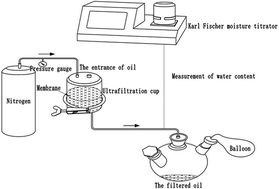A facile dip-coating approach to stable superhydrophobic SiO2/epoxy resin membrane preparation for micro-water separation in transformer oil liquids†
Abstract
In this study, a facile one-step dip-coating approach was reported for superhydrophobic membrane fabrication, in which only epoxy resin and silica nanoparticles were needed. In addition, the surface microstructure and wettability of the membrane were closely related to the content of silica nanoparticles. When the content of silica nanoparticles was 4 wt%, the membrane exhibited optimum surface roughness and superhydrophobicity, by which water was blocked, while oil was allowed to permeate. Through the application of water contact angle, scanning electron microscopy, energy dispersive spectroscopy, thermal gravimetric analysis and Karl Fischer moisture titrator measurements, the membrane examination indicated that the micro/nanostructures enhanced the water repellency, which was similar to the lotus leaf effect. Furthermore, this method is suitable for large-scale production and employed for micro-water separation in transformer oil. This is possible because environmentally friendly and inexpensive materials are adopted and harsh operations, sophisticated equipment and a special atmosphere are avoided.


 Please wait while we load your content...
Please wait while we load your content...